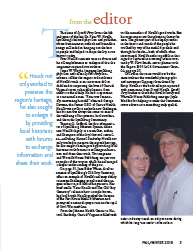From the editor

This issue of Lynch’s Ferry covers the life and times of the late Dr. Peter W. Houck, Lynchburg’s beloved physician and publisher, whose humanitarian outlook and boundless energy succeeded in bringing out the best in people and helped to shape the city as we know it today.
Peter Houck’s interests were so diverse and his accomplishments so widespread that the assignment required two authors:
James W. Wright, longtime Lynchburg physician and recent Lynch’s Ferry contributor, tackles the origins and outcomes of Houck’s work as an innovative doctor dedicated to improving the lives of Central Virginia’s most vulnerable citizens, from infants to the elderly. He had a reputation as a renaissance man. “Peter was continually reinventing himself,” observed George Dawson, the former CEO of Centra Health. Houck was quick to embrace new challenges, but his aim was always the same: to ensure the wellbeing of his patients, his coworkers, and the wider Lynchburg community.
Thomas G. Ledford, the first administrator of Lynchburg Museum System, delves into Houck’s legacy as a researcher, author, and champion of the city’s historic resources—including Historic Sandusky. Houck not only worked to preserve the region’s heritage, he also sought to enlarge it by providing local historians with forums to exchange information and share their work. This magazine and Warwick House Publishing are just two examples of the ways in which he encouraged a deeper understanding of the past.
On page 31, Jane Baber White, director emerita of Lynchburg’s Old City Cemetery, offers an example of Houck’s uncanny ability to initiate challenging projects and then inspire others to join him in his pursuits. Her brief article “Peter Houck and The Old City Cemetery” recounts how a simple brown-bag lunch with Houck sparked the creation of the Pest House Medical Museum and prompted a national symposium on the topic of Civil War medicine.
From the Johnson Health Center to Historic Sandusky, Central Virginia is filled with visible reminders of Houck’s good works. But his most important contributions cannot be seen. The greatest part of his legacy resides in the hearts and minds of the people he touched by way of his medical practice and through his books—both of which often intertwined. Houck’s enduring effect in this regard is captured in a moving tribute written by W. Scott Smith, senior planner with the Region 2000 Local Government Council, on page 27.
Of course, this issue would not be the same without the wonderful photographs and newspaper clippings contributed by Betsy Houck or the book excerpts reprinted with permission from David Houck. Lynch’s Ferry wishes to thank the Houck family and Warwick House Publishing manager Joyce Maddox for helping to make this commemorative edition into something truly special.
Peter Houck’s interests were so diverse and his accomplishments so widespread that the assignment required two authors:
James W. Wright, longtime Lynchburg physician and recent Lynch’s Ferry contributor, tackles the origins and outcomes of Houck’s work as an innovative doctor dedicated to improving the lives of Central Virginia’s most vulnerable citizens, from infants to the elderly. He had a reputation as a renaissance man. “Peter was continually reinventing himself,” observed George Dawson, the former CEO of Centra Health. Houck was quick to embrace new challenges, but his aim was always the same: to ensure the wellbeing of his patients, his coworkers, and the wider Lynchburg community.
Thomas G. Ledford, the first administrator of Lynchburg Museum System, delves into Houck’s legacy as a researcher, author, and champion of the city’s historic resources—including Historic Sandusky. Houck not only worked to preserve the region’s heritage, he also sought to enlarge it by providing local historians with forums to exchange information and share their work. This magazine and Warwick House Publishing are just two examples of the ways in which he encouraged a deeper understanding of the past.
On page 31, Jane Baber White, director emerita of Lynchburg’s Old City Cemetery, offers an example of Houck’s uncanny ability to initiate challenging projects and then inspire others to join him in his pursuits. Her brief article “Peter Houck and The Old City Cemetery” recounts how a simple brown-bag lunch with Houck sparked the creation of the Pest House Medical Museum and prompted a national symposium on the topic of Civil War medicine.
From the Johnson Health Center to Historic Sandusky, Central Virginia is filled with visible reminders of Houck’s good works. But his most important contributions cannot be seen. The greatest part of his legacy resides in the hearts and minds of the people he touched by way of his medical practice and through his books—both of which often intertwined. Houck’s enduring effect in this regard is captured in a moving tribute written by W. Scott Smith, senior planner with the Region 2000 Local Government Council, on page 27.
Of course, this issue would not be the same without the wonderful photographs and newspaper clippings contributed by Betsy Houck or the book excerpts reprinted with permission from David Houck. Lynch’s Ferry wishes to thank the Houck family and Warwick House Publishing manager Joyce Maddox for helping to make this commemorative edition into something truly special.
^ Top
Previous page: Fall 2015
Next page: Crossing Boundaries: The Pioneering Career of Dr. Peter W. Houck
Site Map




